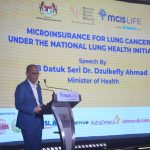Cancer remains the second leading cause of death in Malaysia, with breast cancer being the most common type, accounting for 31.3% of all cases (Bray et al., 2024; Yip et al., 2014). Malaysian women tend to develop breast cancer at a younger age compared to Western populations—approximately half of all cases are diagnosed before the age of 50, compared to only 20% in countries such as the UK and the Netherlands.
According to the Malaysian National Cancer Registry Report (MNCRR 2017–2021), breast cancer incidence continues to rise, particularly among women aged 65–69. Mortality has also increased from 10.9% to 13%, largely due to late-stage diagnosis. Despite ongoing improvements in healthcare infrastructure, delayed detection continues to undermine survival outcomes, underscoring the urgent need for comprehensive and equitable early detection strategies.
The World Health Organization’s Global Breast Cancer Initiative (GBCI) aims to reduce global breast cancer mortality by 2.5% annually by 2040 through three strategic pillars:
- Early detection – diagnosing over 60% of invasive cancers at stages I or II;
- Timely diagnosis – completing breast diagnostic assessments within 60 days; and
- Treatment completion – ensuring at least 80% of patients receive multidisciplinary care (GBCI, 2023).
This framework specifically targets low- and middle-income countries (LMICs), including Malaysia, where structural, socioeconomic, and cultural barriers continue to drive higher mortality rates.
Early detection significantly improves survival and treatment success. The five-year survival rate for early-stage breast cancer exceeds 90% (Giaquinto et al., 2022). Moreover, early diagnosis often allows for less invasive and more cost-effective treatment options—such as lumpectomy instead of mastectomy—thereby reducing both physical and financial burdens. Countries with well-organised screening programmes, such as the United States and Canada, have demonstrated notable improvements in survival outcomes through systematic early detection (Ong et al., 2024).
Mammography and the Malaysian context
Mammography remains the gold standard for screening asymptomatic women, enabling tumour detection before symptoms appear and improving the chances of cure. The Ministry of Health Malaysia (MOH) recommends biennial mammograms for women aged 50–74, while women aged 40–49 are encouraged to discuss individual risk factors and screening benefits with their healthcare providers (MOH, 2022).
However, national uptake remains low. Fewer than 30% of eligible women undergo regular mammograms, with particularly low participation among rural and lower-income groups (Tan et al., 2023). This underutilisation is compounded by several factors—misconceptions that mammography is only necessary when symptoms occur, fear of diagnosis, financial constraints, and limited access to screening facilities in semi-urban and rural regions (Yip et al., 2014; Mohan et al., 2021).
Expanding access to subsidised or mobile mammography units, strengthening health literacy, and integrating patient navigation systems are critical to enhancing early detection nationwide. Evidence from the NCSM-ETIQA Mammogram Subsidy Programme and civil society initiatives such as the Saringan Harapan Pink campaign demonstrate that targeted awareness and accessibility interventions can substantially increase screening participation and early detection rates.
Late-stage diagnosis and systemic barriers
Despite these efforts, late-stage diagnosis remains a significant challenge in Malaysia, with over half (50.5%) of breast cancer cases detected at advanced stages (MNCRR 2017–2021). Limited screening participation is only part of the issue; systemic barriers—such as delays in diagnosis and treatment initiation—also contribute to poorer outcomes (Jassem et al., 2014; Ginsburg et al., 2020).
Barriers to screening and follow-up care are complex and multifaceted. In LMICs, follow-up rates after positive screening results are often low; for instance, only 35% of women in the Philippines and 42.8% in rural Jakarta complete diagnostic assessments (Pisani et al., 2006; Kardinah et al., 2014). Similarly, in Malaysia, Tan et al. (2023) found that 70.7% of women believed mammograms were only necessary when symptoms appeared. Fear of diagnosis and logistical challenges further deter participation, while delays in diagnostic confirmation after abnormal findings reveal weaknesses in post-screening care (Mohan et al., 2021).
Reece et al. (2021) identified comparable gaps in the United States, where follow-up rates after abnormal mammograms were hindered by system-level coordination issues and patient-related factors such as fear and low health literacy. Interventions like patient navigation programmes, streamlined communication, and coordinated care pathways have proven effective in reducing these delays and could be adapted to Malaysia’s healthcare context.
The role of social support
Social and emotional support play pivotal roles in ensuring adherence to screening, follow-up, and treatment. Women with strong familial and community support are more likely to complete diagnostic assessments and initiate treatment promptly (Simoni et al., 2006; Rajaram et al., 2023). In Malaysia, addressing emotional and logistical barriers through community-based support systems could significantly strengthen the cancer care continuum.
Aligning national cancer control strategies with the GBCI’s goal of completing diagnostics within 60 days (Ong et al., 2024) will be vital to improving survival outcomes and reducing mortality.
Effective early detection, timely diagnosis, and robust social support systems are essential to improving breast cancer outcomes in Malaysia. Mammography remains a cornerstone of these efforts, offering a proven pathway to early detection and reduced mortality. Strengthening healthcare systems, addressing cultural and logistical barriers, and ensuring timely follow-up after screening are key to bridging existing gaps and advancing Malaysia’s progress toward global breast cancer control goals.






